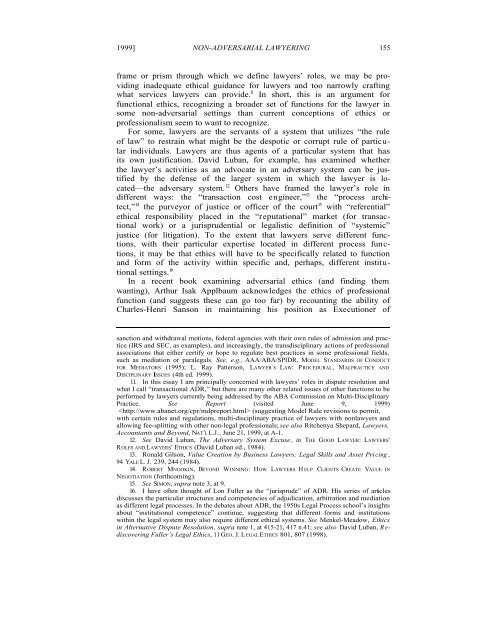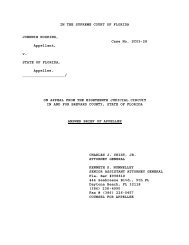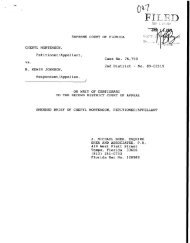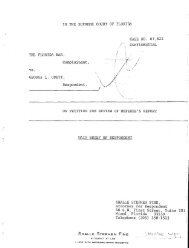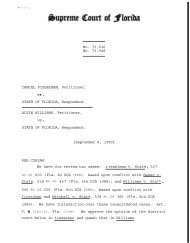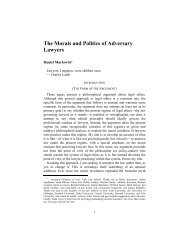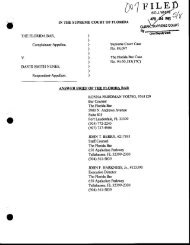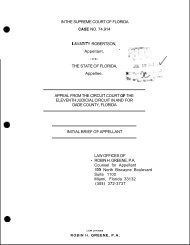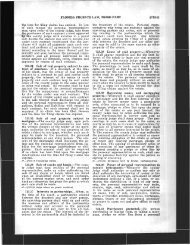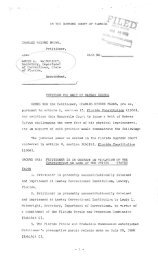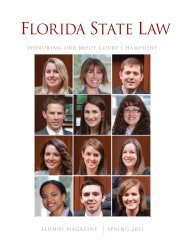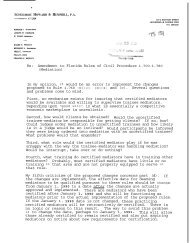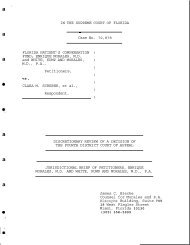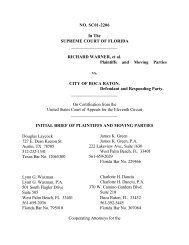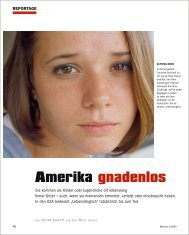ethics and professionalism in non- adversarial lawyering
ethics and professionalism in non- adversarial lawyering
ethics and professionalism in non- adversarial lawyering
You also want an ePaper? Increase the reach of your titles
YUMPU automatically turns print PDFs into web optimized ePapers that Google loves.
1999] NON-ADVERSARIAL LAWYERING 155<br />
frame or prism through which we def<strong>in</strong>e lawyers’ roles, we may be provid<strong>in</strong>g<br />
<strong>in</strong>adequate ethical guidance for lawyers <strong>and</strong> too narrowly craft<strong>in</strong>g<br />
what services lawyers can provide. 11 In short, this is an argument for<br />
functional <strong>ethics</strong>, recogniz<strong>in</strong>g a broader set of functions for the lawyer <strong>in</strong><br />
some <strong>non</strong>-<strong>adversarial</strong> sett<strong>in</strong>gs than current conceptions of <strong>ethics</strong> or<br />
<strong>professionalism</strong> seem to want to recognize.<br />
For some, lawyers are the servants of a system that utilizes “the rule<br />
of law” to restra<strong>in</strong> what might be the despotic or corrupt rule of particular<br />
<strong>in</strong>dividuals. Lawyers are thus agents of a particular system that has<br />
its own justification. David Luban, for example, has exam<strong>in</strong>ed whether<br />
the lawyer’s activities as an advocate <strong>in</strong> an adversary system can be justified<br />
by the defense of the larger system <strong>in</strong> which the lawyer is located—the<br />
adversary system. 12 Others have framed the lawyer’s role <strong>in</strong><br />
different ways: the “transaction cost eng<strong>in</strong>eer,” 13 the “process architect,”<br />
14 the purveyor of justice or officer of the court 15 with “referential”<br />
ethical responsibility placed <strong>in</strong> the “reputational” market (for transactional<br />
work) or a jurisprudential or legalistic def<strong>in</strong>ition of “systemic”<br />
justice (for litigation). To the extent that lawyers serve different functions,<br />
with their particular expertise located <strong>in</strong> different process functions,<br />
it may be that <strong>ethics</strong> will have to be specifically related to function<br />
<strong>and</strong> form of the activity with<strong>in</strong> specific <strong>and</strong>, perhaps, different <strong>in</strong>stitutional<br />
sett<strong>in</strong>gs. 16<br />
In a recent book exam<strong>in</strong><strong>in</strong>g <strong>adversarial</strong> <strong>ethics</strong> (<strong>and</strong> f<strong>in</strong>d<strong>in</strong>g them<br />
want<strong>in</strong>g), Arthur Isak Applbaum acknowledges the <strong>ethics</strong> of professional<br />
function (<strong>and</strong> suggests these can go too far) by recount<strong>in</strong>g the ability of<br />
Charles-Henri Sanson <strong>in</strong> ma<strong>in</strong>ta<strong>in</strong><strong>in</strong>g his position as Executioner of<br />
sanction <strong>and</strong> withdrawal motions, federal agencies with their own rules of admission <strong>and</strong> practice<br />
(IRS <strong>and</strong> SEC, as examples), <strong>and</strong> <strong>in</strong>creas<strong>in</strong>gly, the transdiscipl<strong>in</strong>ary actions of professional<br />
associations that either certify or hope to regulate best practices <strong>in</strong> some professional fields,<br />
such as mediation or paralegals. See, e.g., AAA/ABA/SPIDR, MODEL STANDARDS OF CONDUCT<br />
FOR MEDIATORS (1995); L. Ray Patterson, LAWYER’ S LAW: P ROCEDURAL, MALPRACTICE AND<br />
DISCIPLINARY ISSUES (4th ed. 1999).<br />
11. In this essay I am pr<strong>in</strong>cipally concerned with lawyers’ roles <strong>in</strong> dispute resolution <strong>and</strong><br />
what I call “transactional ADR,” but there are many other related issues of other functions to be<br />
performed by lawyers currently be<strong>in</strong>g addressed by the ABA Commission on Multi-Discipl<strong>in</strong>ary<br />
Practice. See Report (visited June 9, 1999)<br />
(suggest<strong>in</strong>g Model Rule revisions to permit,<br />
with certa<strong>in</strong> rules <strong>and</strong> regulations, multi-discipl<strong>in</strong>ary practice of lawyers with <strong>non</strong>lawyers <strong>and</strong><br />
allow<strong>in</strong>g fee-splitt<strong>in</strong>g with other <strong>non</strong>-legal professionals; see also Ritchenya Shepard, Lawyers,<br />
Accountants <strong>and</strong> Beyond, NAT’L L.J., June 21, 1999, at A-1.<br />
12. See David Luban, The Adversary System Excuse, <strong>in</strong> THE GOOD LAWYER: LAWYERS’<br />
ROLES AND LAWYERS’ ETHICS (David Luban ed., 1984).<br />
13. Ronald Gilson, Value Creation by Bus<strong>in</strong>ess Lawyers: Legal Skills <strong>and</strong> Asset Pri c<strong>in</strong>g ,<br />
94 YALE L. J. 239, 244 (1984).<br />
14. ROBERT MNOOKIN, BEYOND WINNING: HOW LAWYERS H ELP CLIENTS CREATE VALUE IN<br />
NEGOTIATION (forthcom<strong>in</strong>g).<br />
15. See SIMON, supra note 3, at 9.<br />
16. I have often thought of Lon Fuller as the “jurisprude” of ADR. His series of articles<br />
discusses the particular structures <strong>and</strong> competencies of adjudication, arbitration <strong>and</strong> mediation<br />
as different legal processes. In the debates about ADR, the 1950s Legal Process school’s <strong>in</strong>sights<br />
about “<strong>in</strong>stitutional competence” cont<strong>in</strong>ue, suggest<strong>in</strong>g that different forms <strong>and</strong> <strong>in</strong>stitutions<br />
with<strong>in</strong> the legal system may also require different ethical systems. See Menkel-Meadow, Ethics<br />
<strong>in</strong> Alternative Dispute Resolution, supra note 1, at 415-21, 417 n.41; see also David Luban, R e-<br />
discover<strong>in</strong>g Fuller’s Legal Ethics, 11 GEO. J. L EGAL ETHICS 801, 807 (1998).


